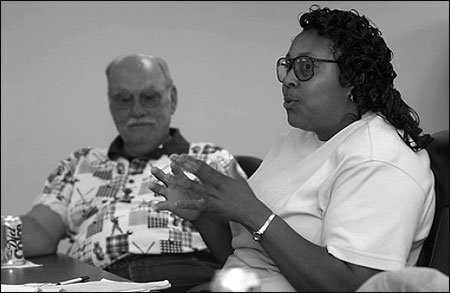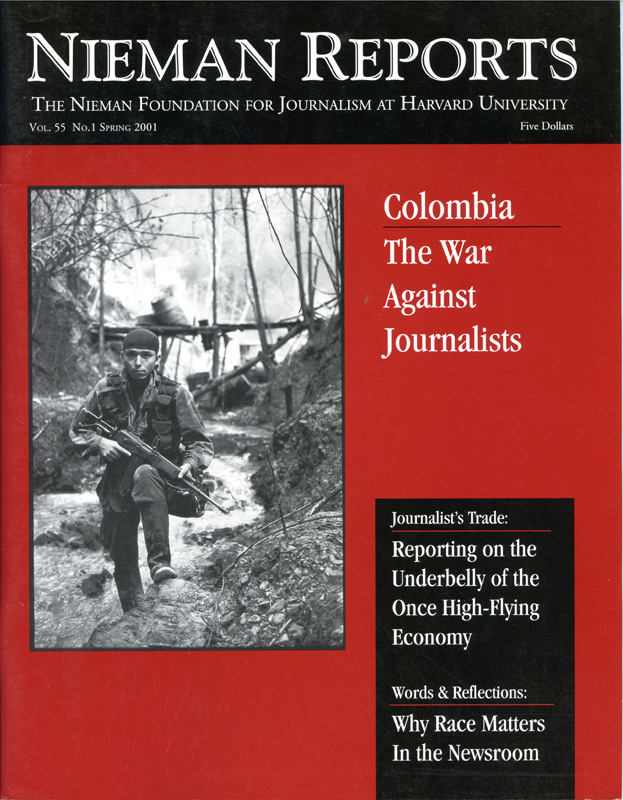
Should alcohol be sold on Sundays in Monroe? The politicians were saying yes, but backed off after The News-Star published residents’ opinions. Here, Joyce Powell discusses Sunday alcohol sales as Forrest Harvey listens. Photo by Margaret Croft.
Name any street in Monroe, Louisiana, and most News-Star staffers will not only tell you where it is, but also give you some landmarks.
We know what’s where. And we thought we knew what was what.
But what we really knew was that our community faced an ever-growing crevasse of race, fueled by a geography that separated the white north from the black south as definitively as the Mason-Dixon line. We knew the black-white division wasn’t a black-and-white issue, yet our reporting hadn’t penetrated the civic layers beyond the political arena to open a community dialogue about basic economic and trust issues that affected people’s daily lives and interactions.
In covering the news of our community, we seemed to only position the newspaper even further from the African-American community. Legendary Grambling State University football coach Eddie Robinson was sanctioned by the NCAA, and our newspaper sued for access to public records. Monroe’s first African-American mayor filled city hall with cronies, including a department head who was indicted for bid-rigging. Both minority weekly newspapers accused the News-Star of conspiring with other media to destroy strong black men. We knew the conspiracy theorists were wrong, but some of our traditional sources dried up because of the distrust that this perception engendered. We had to find new ways to reconnect with our community.
The concept of civic mapping appeared to provide opportunities to reconnect. We applied to the Pew Center for Civic Journalism to receive training. By learning, and now using, civic mapping techniques taught by The Harwood Institute and the Pew Center, we’ve embarked on a path that is leading us to more balanced coverage. By applying these methods of reporting, our newspaper is able to portray all members of our community in a fairer and more accurate light.
Even before we learned about civic mapping, our reporters had tapped ordinary citizens, known in our newsroom as “real people,” to comment for publication on all topics. We were careful to include minorities into our coverage. Yet, by the time we sought their input, the agenda for the article had been set and their quotes were simply inserted. Often, this approach ended up putting them on the spot, asking their thoughts on the particular issue we were covering in our story.
When we turned the tables and began to encourage “real” people to tell us their concerns, their responses became more genuine. As a result, we moved closer to writing about actual issues in the life of our community. Civic mapping’s core concept—going beyond the usual interviewees and building relationships with people described as community connectors—has forced The News-Star’s reporters away from their newsroom desks and into barber shops, community centers, and coffee shops to enhance their ability to find reliable and informative sources.
We’ve also re-learned the art of conversational interviewing, which relaxes an interviewee who might not be accustomed to a news reporter’s style of questioning. We’ve discovered that asking someone “What do you make of that?” can be a magical query, one that is far less threatening than “What do you think?”
Recently the newspaper convened a civic mapping conversation about race relationships in our city that brought minority concerns into the public arena. A sampling of those concerns follows:
- Few retail stores remain open at night in minority residential areas. “If I take sick tonight and an aspirin will save my life, you know where I have to get the aspirin? I have to cross Louisville (a street known as the geographic black-white dividing line) to save my life to get an aspirin,” a high school assistant principal said.
- Longstanding economic discrimination involves government and quasi-government agencies. “Why can’t we have a post office on the south side of Monroe?” a reader asked, as the conversation turned to a new post office under construction less than three miles from three existing ones. “You have to go all the way to the north of Monroe for a cotton-picking stamp to mail a letter.”
In another story driven by the civic mapping approach, a reporter experienced firsthand with a neighborhood just how miserable it can be to live downwind from a sewer treatment plant. This perspective was chosen for the story instead of corralling the usual city hall sources for an article about the need to replace the aging facility.
These are places, people and issues we pass every day. It’s our community. We thought we knew it. But this familiarity also had instilled in us natural biases, blinding us and hindering our ability to uncover meaningful stories. Civic mapping has restored our vigorous curiosity. It’s teaching us how much we have to learn about the place all of us call home.

An assistant principal talks about economic disparity faced by African Americans as The News-Star’s managing editor listens. Photo by Margaret Croft.
Kathy Spurlock, executive editor of The (Monroe, La.) News-Star since 1995, has served in various writing and editing capacities at The News-Star, The (Baton Rouge, La.) Advocate, and The (Jackson, Miss.) Clarion-Ledger since 1975. Her newspaper is the current recipient of a Pew Center grant to use civic mapping and other techniques to enhance public involvement with the Monroe school system and to teach these techniques to civic journalism students at Louisiana Tech and Grambling State Universities.


